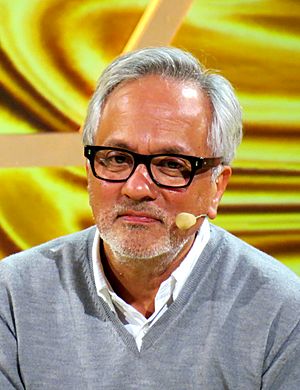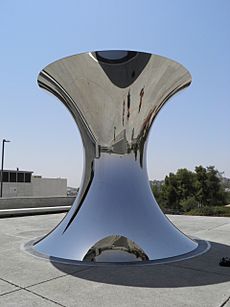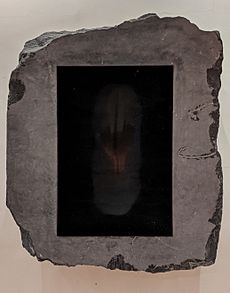Anish Kapoor facts for kids
Quick facts for kids
Sir Anish Kapoor
|
|
|---|---|

Kapoor in 2017
|
|
| Born |
Anish Mikhail Kapoor
12 March 1954 Bombay, India
|
| Nationality | Indian, British |
| Education |
|
| Known for | Sculpture |
|
Notable work
|
|
| Spouse(s) |
Susanne Spicale
(m. 1995; div. 2013)Sophie Walker
(m. 2016; div. 2023)Oumaima Boumoussaoui
(m. 2023) |
| Awards |
|
Sir Anish Mikhail Kapoor (born March 12, 1954) is a famous British sculptor. He is known for creating large art pieces called installation art and conceptual art. Anish Kapoor was born in Mumbai, India. He later moved to the United Kingdom to study art.
Some of his most famous public sculptures include Cloud Gate (also known as "The Bean") in Chicago. He also created Sky Mirror, which has been shown in New York City and London. Another well-known work is ArcelorMittal Orbit, a tall sculpture made for the London Olympic Park.
Anish Kapoor has received many awards for his art. These include the Turner Prize in 1991 and a knighthood in 2013. His image was even featured in the British passport in 2015 as a British cultural icon.
Contents
Early Life and Art Training
Anish Mikhail Kapoor was born in Mumbai, India. His father was an Indian hydrographer (someone who maps water bodies). His mother came from an Iraqi Jewish family. Anish has a brother named Ilan Kapoor, who is a professor.
Anish went to The Doon School, a boarding school in India. In 1971, he moved to Israel with one of his brothers. He tried studying electrical engineering but found it difficult. After six months, he decided he wanted to be an artist instead.
In 1973, Anish Kapoor moved to Britain to study art. He attended Hornsey College of Art and later Chelsea School of Art and Design. He found inspiration from an artist named Paul Neagu. Since the early 1970s, Kapoor has lived and worked in London.
His Art Career
Anish Kapoor became well-known in the 1980s for his sculptures. He used simple materials like granite, limestone, marble, and plaster. Many of these early sculptures were simple, curved shapes. They were often one color and brightly colored, using powder pigment (color) to make their form.
He called some of these early works A Thousand Names. He said the powder made the objects look like they were partly hidden, like icebergs. This use of powder was seen in his first big exhibition in London in 1978.
In the late 1980s and 1990s, Kapoor explored ideas of "matter" (things you can touch) and "non-matter" (like empty space). Many of his sculptures seem to disappear or change the space around them. He started working with stone in 1987. These stone works often have holes or hollow parts. They play with ideas like earth and sky, or light and dark.
Since 1995, he has used shiny, polished stainless steel. These works are like mirrors, reflecting or changing how the viewer and surroundings look. Over time, Kapoor's sculptures became even bigger and more complex. He created large pieces like Taratantara (1999) and Marsyas (2002). Marsyas was a huge work in the Turbine Hall of Tate Modern in London.
Kapoor also uses red wax in his art. This material can make people think of flesh or blood. In 2007, he showed Svayambh, a large block of red wax that moved on rails. This piece was shown again in Munich and London. Some of Kapoor's art mixes with architecture. In 2008, he made Memory, a large piece in Cor-Ten steel, which rusts to create a protective layer.
In 2009, Kapoor had a big solo exhibition at the Royal Academy of Arts. This show included new works, like Shooting into the Corner. This artwork uses a cannon to fire wax pellets into a corner of the gallery. The wax slowly builds up, creating a new shape.
In 2011, Kapoor's work Leviathan was shown at the Grand Palais in Paris. He described it as a single, huge object that visitors could walk inside. He wanted it to be a peaceful and artistic experience.
He also exhibited Dirty Corner in Milan in 2011. This work was a huge steel tunnel, 60 meters long. Visitors walked inside, and it became darker and darker. Outside, the tunnel was slowly covered by a large amount of earth.
In 2018, Kapoor had a legal issue with the National Rifle Association of America (NRA). They used an image of his sculpture Cloud Gate in a video without his permission. The issue was resolved, and the NRA removed his artwork from their video.
Public Artworks

Anish Kapoor has created many artworks for public spaces. One of his first public pieces was Cast Iron Mountain in Japan. In 2001, Sky Mirror, a large mirror sculpture, was made for a spot outside the Nottingham Playhouse.
Since 2006, Cloud Gate, also known as "The Bean," has been a permanent sculpture in Millennium Park in Chicago. This 110-ton stainless steel sculpture has a shiny surface. People can walk under it and look up into a special curved space.
In 2006, another large Sky Mirror was placed at Rockefeller Center in New York City. This artwork was later shown in Kensington Gardens in London in 2010.
In 2009, Kapoor created Earth Cinema for Pollino National Park in Italy. This work is a long, deep cut into the landscape made from concrete and earth. People can walk inside it and see the earth around them.
He was also asked to create five public art pieces called the Tees Valley Giants. The first of these, Temenos, was shown in 2010. It is 50 meters high and 110 meters long, made of steel wire mesh.
In 2010, Turning the World Upside Down, Jerusalem was installed at the Israel Museum. This sculpture is a 16-foot tall polished-steel hourglass. It reflects the sky and the museum's surroundings.
The Orbit sculpture was chosen for the Olympic Park of the 2012 Olympic Games in London. At 115 meters tall, Orbit is the tallest sculpture in the UK.
Working with Buildings
Anish Kapoor has often worked with architects and engineers. He sees these projects as a mix of sculpture and architecture.
Some of his important building projects include:
- Ark Nova, a concert hall that can be inflated. It travels to areas in Japan affected by earthquakes. He designed it with architect Arata Isozaki.
- Orbit, the tall sculpture for London's Olympic Park, created with engineer Cecil Balmond.
- Temenos, the first of the Tees Valley Giants, also with Cecil Balmond.
- Dismemberment Site 1, installed at the Gibbs Farm sculpture park in New Zealand.
- A building at 56 Leonard Street in New York, with architects Herzog and de Meuron.
- Two subway stations in Naples, Italy, with Future Systems.
Stage Designs
Kapoor has also designed sets for plays and operas. These include the opera Idomeneo in 2003 and a dance-theatre piece called in-i in London.
Anish Kapoor Foundation
The Anish Kapoor Foundation was started in 2017. In 2018, Kapoor bought a building in Venice, Italy, called Palazzo Priuli Manfrin. The foundation plans to turn this building into an exhibition space, an artist studio, and a place to store some of his artworks.
Exhibitions
Anish Kapoor first started showing his art as part of the New British Sculpture art scene. His first solo exhibition was in Paris in 1980. He became widely known when he represented Britain at the Venice Biennale in 1990.
His solo exhibitions have been held in famous places like the Tate and Hayward Gallery in London. His work has also been shown at the Guggenheim in Bilbao and New York City.
In 2008, the Institute of Contemporary Art in Boston held a big show of his work. In 2009, Kapoor was the first living artist to have a solo exhibition at the Royal Academy in London. This show was very popular, attracting many visitors.
In 2010, his art was shown in India, the country where he was born. In 2012-2013, he had a major exhibition at the Museum of Contemporary Art, Sydney (MCA) in Australia.
In 2015, his artwork Dirty Corner was shown at the Palace of Versailles in France. In 2020, Kapoor showed a new exhibition at Houghton Hall in Norfolk, England. This was his largest outdoor exhibition, with 21 sculptures. In 2024, Liverpool Cathedral hosted an exhibition of his work.
Where His Art Is Collected
Anish Kapoor's art is collected by museums all over the world. Some of these include:
- The Museum of Modern Art in New York City
- Tate Modern in London
- The Art Gallery of New South Wales, Sydney
- The Guggenheim in Bilbao
- The Israel Museum in Jerusalem
Personal Life
Family
Anish Kapoor has been married three times. He first married Susanne Spicale in 1995. They had a daughter and a son before they divorced in 2013.
He later married Sophie Walker in 2016. They had one daughter together and divorced in 2023. In 2023, Kapoor married Oumaima Boumoussaoui.
Homes
Anish Kapoor lives in London. He also owns a home in New York City and on Harbour Island, Bahamas.
Awards and Honours
Artistic Awards
- 1990 Premio Duemila, Venice Biennale
- 1991 Turner Prize
- 1999 Elected Royal Academician (a special honor for artists in the UK)
- 2011 Praemium Imperiale (a global arts prize)
Civilian Honours
- 2003 Commander of the Order of the British Empire (CBE)
- 2011 French Ordre des Arts et des Lettres (Order of Arts and Letters)
- 2012 Padma Bhushan, India's third-highest civilian honor
- 2013 Knighthood (meaning he is now called "Sir")
Other Honours
- 2016 LennonOno Grant for Peace
- 2017 Genesis Prize (an award for Jewish people who inspire others)
See also
 In Spanish: Anish Kapoor para niños
In Spanish: Anish Kapoor para niños
- Scheps v Fine Art Logistic Ltd



